Learning Management System Analytics on Arithmetic Fluency Performance: A Skill Development Case in K6 Education
Abstract
:1. Introduction
2. Related Work
2.1. Arithmetic Fluency
2.2. Mathematics Interventions in Learning Management Systems
3. Research Context
4. Research Methodology
4.1. Intervention Desgin
4.2. Participants and Setting
4.3. The Integrated Learning Management System
- The main operations (i.e., automated assessment, computerized exam administration, peer review function, construction or editing of new exercises) are performed on dedicated servers, thereby making the platform accessible via any modern web-browser without the need to install specialized software or browser-based plugins.
- The system has been designed with the following principles in mind: (a) instructor–student interaction, (b) student–student interaction, (c) automatic assessment, and (d) immediate feedback.
- An extensive set of premade exercise types and learning materials that can be deployed with little to no effort are readily available, thus making the tool as versatile as possible. To this end, a large variety of assignment delivery methods has also been included to facilitate personalised learning paths (i.e., acquisition of prerequisite knowledge) or the contact of exams.
- To further support teachers’ missions, a built-in tool that facilitates the creation of new exercises, or the customisation of existing exercises, is also in place. Content created by individual teachers (including diversified difficulty levels, gamification elements, marking scales and so on) can be shared (copied) and edited by other community members.
4.4. Data Analysis
5. Results
5.1. Practicing Impact on Students’ Performance
5.2. Practicing Behaviour and Fluency Development
- Students from the 6th grade outnumbered other groups both in fluency improvement and in terms of completed exercises. Moreover, there were no students in this cohort whose performance decreased.
- Students from the 4th grade demonstrated a reasonable improvement over time, although they had been practicing considerably less, having less exercises completed.
- Students from the 5th grade had too intensified variety in their performance and, therefore, we could not draw any definite conclusions regarding their performance.
- Students whose fluency skills improved after practicing for a considerably small amount of time or, otherwise, completing only a small number of exercises.
- Students who spent a considerable amount of time practicing, yet their performance not only did not improve but, instead, was negatively impacted.
5.3. Evaluation of Students’ Performance
6. Discussion
7. Conclusions
- To facilitate the development of students’ mathematic fluency, educational technologists and instructional designers are highly recommended to consider the wider adoption of a curriculum-driven and school-grade specific personalised learning path when integrating digital learning tools. Under this consideration, this study has demonstrated how deliberate and planned practice with self-regulated learning and automatic feedback can promote students’ mathematics competencies and maintain their interest in the subject. This becomes even more crucial when considering the recent pandemic outbreak and the lack of physical interaction between teachers and students.
- Considering the preferences students showed in specific exercises, we can tentatively assume that not all instructional approaches are equally efficiently in training a target skill. Therefore, additional research on the instructional design features and the respective game elements is desired.
- In view of the above, establishing a validated inventory (battery) of tasks for arithmetic fluency development, especially for primary school students, could be particularly helpful for educators and educational technologies.
8. Limitations and Future Directions
Author Contributions
Funding
Institutional Review Board Statement
Informed Consent Statement
Data Availability Statement
Acknowledgments
Conflicts of Interest
References
- Haelermans, C.; Ghysels, J. The Effect of Individualized Digital Practice at Home on Math Skills–Evidence from a Two-Stage Experiment on Whether and Why It Works. Comput. Educ. 2017, 113, 119–134. [Google Scholar] [CrossRef]
- Musti-Rao, S.; Telesman, A.O. Comparing the Effects of Two Practice Conditions on the Subtraction Fact Fluency of Fifth-Grade Students. J. Behav. Educ. 2020, 1–19. [Google Scholar] [CrossRef]
- Tanujaya, B. Development of an Instrument to Measure Higher Order Thinking Skills in Senior High School Mathematics Instruction. J. Educ. Pract. 2016, 7, 144–148. [Google Scholar]
- Anthony, G.; Walshaw, M. Effective Pedagogy in Mathematics. Educational Practices Series-19; UNESCO International Bureau of Education: Geneva, Switzerland, 2009; pp. 1–30. [Google Scholar]
- Shaw, S.T.; Pogossian, A.A.; Ramirez, G. The Mathematical Flexibility of College Students: The Role of Cognitive and Affective Factors. Br. J. Educ. Psychol. 2020, 90, 981–996. [Google Scholar] [CrossRef] [PubMed]
- Lehtinen, E.; Hannula-Sormunen, M.; McMullen, J.; Gruber, H. Cultivating Mathematical Skills: From Drill-and-Practice to Deliberate Practice. ZDM Math. Educ. 2017, 49, 625–636. [Google Scholar] [CrossRef]
- Ericsson, K.A. Summing Up Hours of Any Type of Practice Versus Identifying Optimal Practice Activities: Commentary on Macnamara, Moreau, & Hambrick. Perspect. Psychol. Sci. 2016, 11, 351–354. [Google Scholar] [CrossRef]
- Kourgiantakis, T.; Sewell, K.M.; Bogo, M. The Importance of Feedback in Preparing Social Work Students for Field Education. Clin. Soc. Work J. 2019, 47, 124–133. [Google Scholar] [CrossRef]
- Foster, C. Developing Mathematical Fluency: Comparing Exercises and Rich Tasks. Educ. Stud. Math. 2018, 97, 121–141. [Google Scholar] [CrossRef] [Green Version]
- Tubb, A.L.; Cropley, D.H.; Marrone, R.L.; Patston, T.; Kaufman, J.C. The Development of Mathematical Creativity across High School: Increasing, Decreasing, or Both? Think. Ski. Creat. 2020, 35, 100634. [Google Scholar] [CrossRef]
- Kaskens, J.; Segers, E.; Goei, S.L.; van Luit, J.E.H.; Verhoeven, L. Impact of Children’s Math Self-Concept, Math Self-Efficacy, Math Anxiety, and Teacher Competencies on Math Development. Teach. Teach. Educ. 2020, 94, 103096. [Google Scholar] [CrossRef]
- Kurvinen, E.; Kaila, E.; Laakso, M.-J.; Salakoski, T. Long Term Effects on Technology Enhanced Learning: The Use of Weekly Digital Lessons in Mathematics. Inform. Educ. 2020, 19, 51–75. [Google Scholar] [CrossRef]
- Geary, D.C.; Hoard, M.K.; Byrd-Craven, J.; Nugent, L.; Numtee, C. Cognitive Mechanisms Underlying Achievement Deficits in Children with Mathematical Learning Disability. Child. Dev. 2007, 78, 1343–1359. [Google Scholar] [CrossRef] [PubMed] [Green Version]
- Barnes, M.A.; Clemens, N.H.; Fall, A.-M.; Roberts, G.; Klein, A.; Starkey, P.; McCandliss, B.; Zucker, T.; Flynn, K. Cognitive Predictors of Difficulties in Math and Reading in Pre-Kindergarten Children at High Risk for Learning Disabilities. J. Educ. Psychol. 2020, 112, 685–700. [Google Scholar] [CrossRef]
- Huijsmans, M.D.E.; Kleemans, T.; van der Ven, S.H.G.; Kroesbergen, E.H. The Relevance of Subtyping Children with Mathematical Learning Disabilities. Res. Dev. Disabil. 2020, 104, 103704. [Google Scholar] [CrossRef] [PubMed]
- Rinne, L.F.; Ye, A.; Jordan, N.C. Development of Arithmetic Fluency: A Direct Effect of Reading Fluency? J. Educ. Psychol. 2020, 112, 110–130. [Google Scholar] [CrossRef]
- Brown, R.D.; Schmithorst, V.J.; Kroeger, L. Calculation. In Neuroscience of Mathematical Cognitive Development: From Infancy through Emerging Adulthood; Brown, R.D., Ed.; Springer International Publishing: Cham, Switzerland, 2018; pp. 59–77. [Google Scholar] [CrossRef]
- Reed, H.C.; Gemmink, M.; Broens-Paffen, M.; Kirschner, P.A.; Jolles, J. Improving Multiplication Fact Fluency by Choosing between Competing Answers. Res. Math. Educ. 2015, 17, 1–19. [Google Scholar] [CrossRef] [Green Version]
- Lee, H.K.; Choi, A. Enhancing Early Numeracy Skills with a Tablet-Based Math Game Intervention: A Study in Tanzania. Educ. Tech. Res. Dev. 2020, 68, 3567–3585. [Google Scholar] [CrossRef]
- Cui, J.; Georgiou, G.K.; Zhang, Y.; Li, Y.; Shu, H.; Zhou, X. Examining the Relationship between Rapid Automatized Naming and Arithmetic Fluency in Chinese Kindergarten Children. J. Exp. Child. Psychol. 2017, 154, 146–163. [Google Scholar] [CrossRef]
- Whitney, T.; Hirn, R.G.; Lingo, A.S. Effects of a Mathematics Fluency Program on Mathematics Performance of Students with Challenging Behaviors. Prev. Sch. Fail. Altern. Educ. Child. Youth 2016, 60, 133–142. [Google Scholar] [CrossRef]
- Russo, J.; Hopkins, S. Measuring Mental Computational Fluency with Addition: A Novel Approach; Mathematics Education Research Group of Australasia: Adelaide, Australia, 2018. [Google Scholar]
- Cozad, L.E.; Riccomini, P.J. Effects of Digital-Based Math Fluency Interventions on Learners with Math Difficulties: A Review of the Literature. J. Spec. Educ. Apprenticesh. 2016, 5, 19. [Google Scholar]
- Benavides-Varela, S.; Zandonella Callegher, C.; Fagiolini, B.; Leo, I.; Altoè, G.; Lucangeli, D. Effectiveness of Digital-Based Interventions for Children with Mathematical Learning Difficulties: A Meta-Analysis. Comput. Educ. 2020, 157, 103953. [Google Scholar] [CrossRef]
- Burte, H.; Gardony, A.L.; Hutton, A.; Taylor, H.A. Make-A-Dice Test: Assessing the Intersection of Mathematical and Spatial Thinking. Behav. Res. 2019, 51, 602–638. [Google Scholar] [CrossRef] [PubMed] [Green Version]
- Kormos, J.; Wilby, J. Task Motivation. The Palgrave Handbook of Motivation for Language Learning; Lamb, M., Csizér, K., Henry, A., Ryan, S., Eds.; Springer International Publishing: Cham, Switzerland, 2019; pp. 267–286. [Google Scholar] [CrossRef]
- Begeny, J.C.; Codding, R.S.; Wang, J.; Hida, R.M.; Patterson, S.L.; Kessler, S.; Fields-Turner, F.; Ramos, K.A. An Analysis of Motivation Strategies Used within the Small-Group Accelerating Mathematics Performance through Practice Strategies (AMPPS-SG) Program. Psychol. Sch. 2020, 57, 540–555. [Google Scholar] [CrossRef]
- Nichols, E.G.; Kohn, A. UAE: Brief Review of Education in the United Arabic Emirates. Math. Its Teach. Muslim World 2020, 265–275. [Google Scholar]
- Kamal, K. Education in the United Arab Emirates. WENR 2018. Available online: https://wenr.wes.org/2018/08/education-in-the-united-arab-emirates (accessed on 14 June 2022).
- Jarrah, A.M. The Challenges Faced by Pre-Service Mathematics Teachers during Their Teaching Practice in the UAE: Implications for Teacher Education Programs. Int. J. Learn. Teach. Educ. Res. 2020, 19, 23–34. [Google Scholar] [CrossRef]
- Eltanahy, M.; Forawi, S.; Mansour, N. STEM Leaders and Teachers Views of Integrating Entrepreneurial Practices into STEM Education in High School in the United Arab Emirates. Entrep. Educ. 2020, 3, 133–149. [Google Scholar] [CrossRef]
- Edugain. Edugain UAE: Math Worksheets, Online Tests and Practice. Natl. Curric. 2021. Available online: https://ae.edugain.com/ (accessed on 14 June 2022).
- Woolsey, M.L.; Tennant, L.; Kelly, M.; Rashad, F. Emirati Pre-Service Teachers in Mathematics and Science: An Ecobehavioral Assessment. In Proceedings of the 10th Annual International Conference of Education, Research and Innovation, Seville, Spain, 16–18 November 2017; p. 560. [Google Scholar] [CrossRef]
- Jarrah, A.M. Elementary Schools Mathematics and Science Teachers’ Perspectives on Using English as a Medium of Instruction. Online Submiss. 2020, 8, 473–482. [Google Scholar] [CrossRef]
- Chi Hyun, C.; Asbari, M.; Wijayanti, L.; Santoso, P.; Pramono, R.; Bernarto, I.; Purwanto, A. Implementation of Contextual Teaching and Learning (CTL) to Improve the Concept and Practice of Love for Faith-Learning Integration. Int. J. Control Autom. 2020, 13.1, 365–383. [Google Scholar]
- Walkington, C.; Bernacki, M.L. Personalizing Algebra to Students’ Individual Interests in an Intelligent Tutoring System: Moderators of Impact. Int. J. Artif. Intell. Educ. 2019, 29, 58–88. [Google Scholar] [CrossRef]
- Qushem, U.B.; Christopoulos, A.; Oyelere, S.S.; Ogata, H.; Laakso, M.-J. Multimodal Technologies in Precision Education: Providing New Opportunities or Adding More Challenges? Educ. Sci. 2021, 11, 338. [Google Scholar] [CrossRef]
- Christopoulos, A.; Kajasilta, H.; Salakoski, T.; Laakso, M.-J. Limits and Virtues of Educational Technology in Elementary School Mathematics. J. Educ. Technol. Syst. 2020, 49, 59–81. [Google Scholar] [CrossRef]
- Hoyles, C. Transforming the Mathematical Practices of Learners and Teachers through Digital Technology. Res. Math. Educ. 2018, 20, 209–228. [Google Scholar] [CrossRef]
- Christopoulos, A.; Sprangers, P. Integration of educational technology during the Covid-19 pandemic: An analysis of teacher and student receptions. Cogent. Educ. 2021, 8, 1964690. [Google Scholar] [CrossRef]
- Koponen, T.; Mononen, R. The 2-Minute Subtraction Fluency Test. In Unpublished Test Material; Niilo Mäki Instituutti: Jyvaskyla, Finland, 2010. [Google Scholar]
- Laakso, M.-J.; Kaila, E.; Rajala, T. ViLLE—Collaborative Education Tool: Designing and Utilizing an Exercise-Based Learning Environment. Educ. Inf. Technol. 2018, 23, 1655–1676. [Google Scholar] [CrossRef]
- Carr, J.E. Recommendations for Reporting Multiple-Baseline Designs across Participants. Behav. Interv. 2005, 20, 219–224. [Google Scholar] [CrossRef]
- Mc Caleb, K.N.; Andersen, A.; Hueston, H. An investigation of school violence and pre-service teachers. Curr. Issues Educ. 2008, 10, 11. [Google Scholar]
- Tukey, J.W. Exploratory Data Analysis; Addison Wesley: Reading, PA, USA, 1977; Volume 2, pp. 131–160. [Google Scholar]
- Qushem, U.B.; Christopoulos, A.; Laakso, M.-J. The Value Proposition of An Integrated Multimodal Learning Analytics Framework. In Proceedings of the 45th Jubilee International ICT Convention on Information, Communication and Electronic Technology (MIPRO), Opatija, Croatia, 23–27 May 2022; pp. 666–671. [Google Scholar] [CrossRef]
- Dweck, C.S. Motivational Processes Affecting Learning. Am. Psychol. 1986, 41, 1040–1048. [Google Scholar] [CrossRef]
- Senko, C.; Miles, K.M. Pursuing Their Own Learning Agenda: How Mastery-Oriented Students Jeopardize Their Class Performance. Contemp. Educ. Psychol. 2008, 33, 561–583. [Google Scholar] [CrossRef]
- Cartwright, K. “Because 7 and 8 Are Always in All of Them”: What Do Students Write and Say to Demonstrate Their Mathematical Fluency? Mathematics Education Research Group of Australasia: Adelaide, Australia, 2019. [Google Scholar]
- Hwang, G.-J.; Wang, S.-Y.; Lai, C.-L. Effects of a Social Regulation-Based Online Learning Framework on Students’ Learning Achievements and Behaviors in Mathematics. Comput. Educ. 2021, 160, 104031. [Google Scholar] [CrossRef]
- López-Pernas, S.; Gordillo, A.; Barra, E.; Quemada, J. Analyzing Learning Effectiveness and Students’ Perceptions of an Educational Escape Room in a Programming Course in Higher Education. IEEE Access 2019, 7, 184221–184234. [Google Scholar] [CrossRef]
- Arnab, S.; Lim, T.; Carvalho, M.B.; Bellotti, F.; Freitas, S.; Louchart, S.; Suttie, N.; Berta, R.; De Gloria, A. Mapping learning and game mechanics for serious games analysis. Br. J. Educ. Technol. 2015, 46, 391–411. [Google Scholar] [CrossRef] [Green Version]
- Seminelli, M.D. Interventions to Develop a Growth Mindset in a Remedial Math Classroom. Math. Mil. 2018, 23, 3. [Google Scholar]
- Maki, K.E.; Zaslofksy, A.F.; Knight, S.; Ebbesmeyer, A.M.; Chelmo-Boatman, A. Intervening with Multiplication Fact Difficulties: Examining the Utility of the Instructional Hierarchy to Target Interventions. J. Behav. Educ. 2021, 30, 534–558. [Google Scholar] [CrossRef]
- Kochmar, E.; Vu, D.D.; Belfer, R.; Gupta, V.; Serban, I.V.; Pineau, J. Automated Personalized Feedback Improves Learning Gains in An Intelligent Tutoring System. In Artificial Intelligence in Education; Bittencourt, I.I., Cukurova, M., Muldner, K., Luckin, R., Millán, E., Eds.; Lecture Notes in Computer Science; Springer International Publishing: Cham, Switzerland, 2020; pp. 140–146. [Google Scholar] [CrossRef]
- Erümit, A.K.; Çetin, İ. Design Framework of Adaptive Intelligent Tutoring Systems. Educ. Inf. Technol. 2020, 25, 4477–4500. [Google Scholar] [CrossRef]
- Sun, Z.; Xie, K. How Do Students Prepare in the Pre-Class Setting of a Flipped Undergraduate Math Course? A Latent Profile Analysis of Learning Behavior and the Impact of Achievement Goals. Internet High. Educ. 2020, 46, 100731. [Google Scholar] [CrossRef]

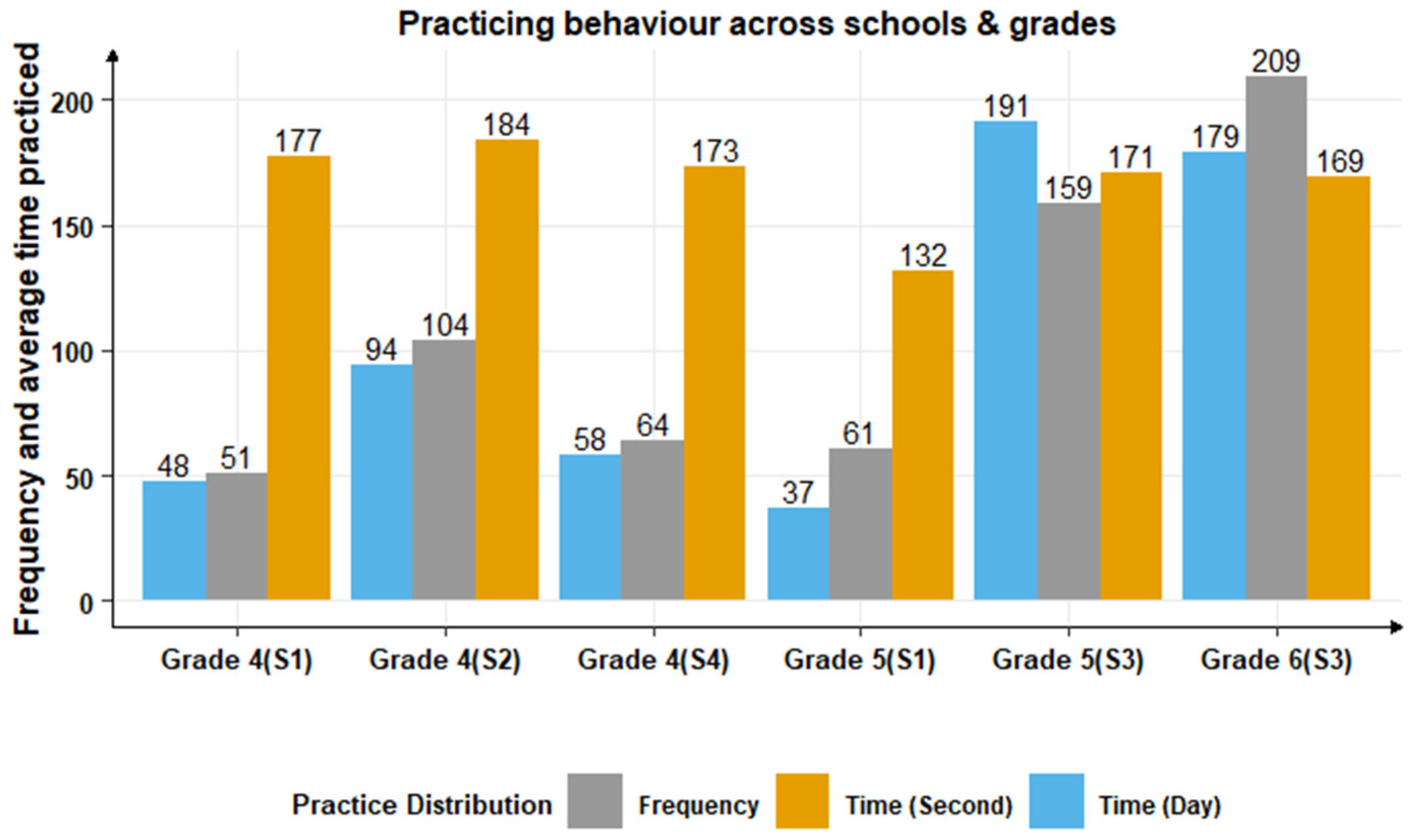
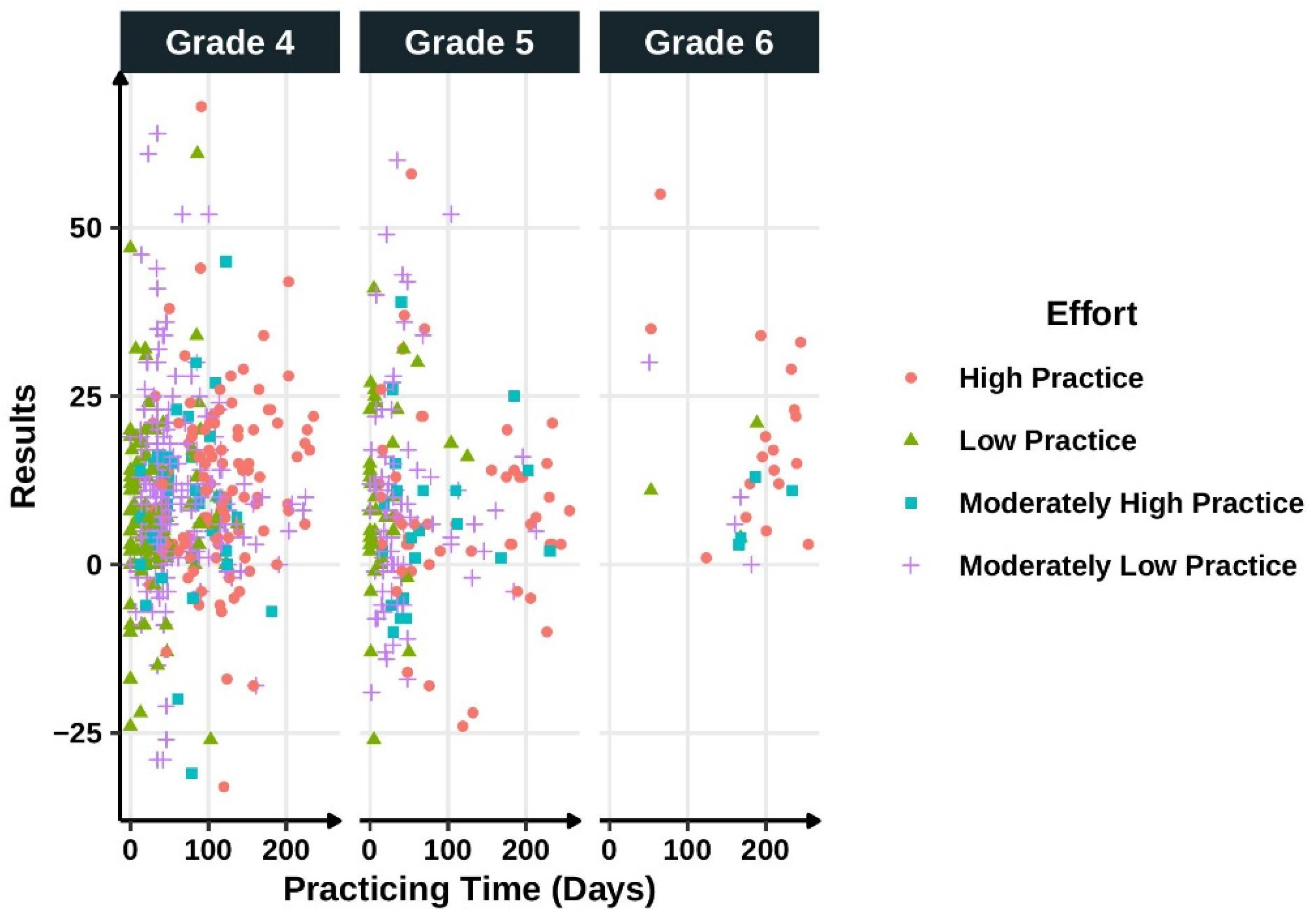
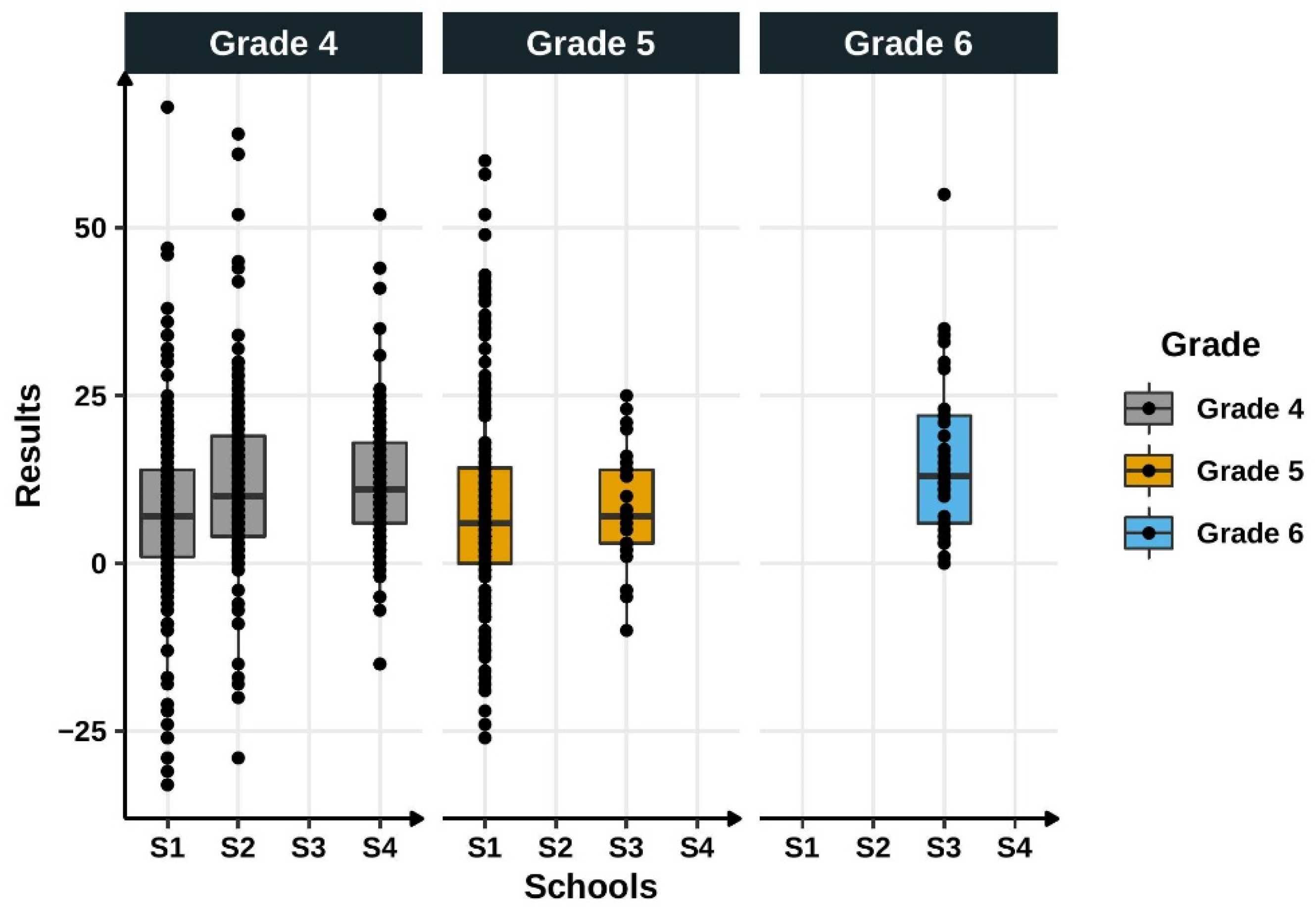
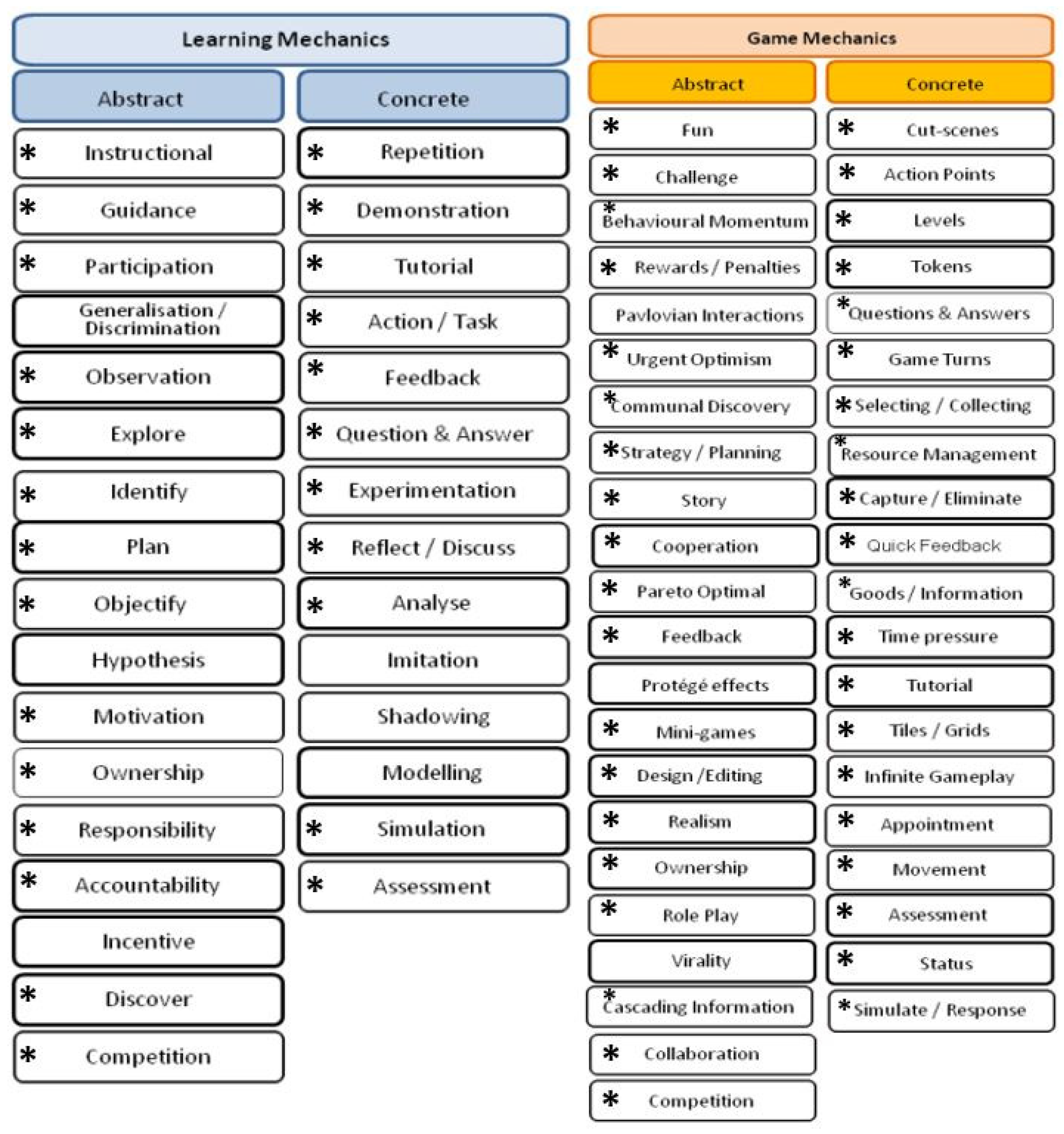
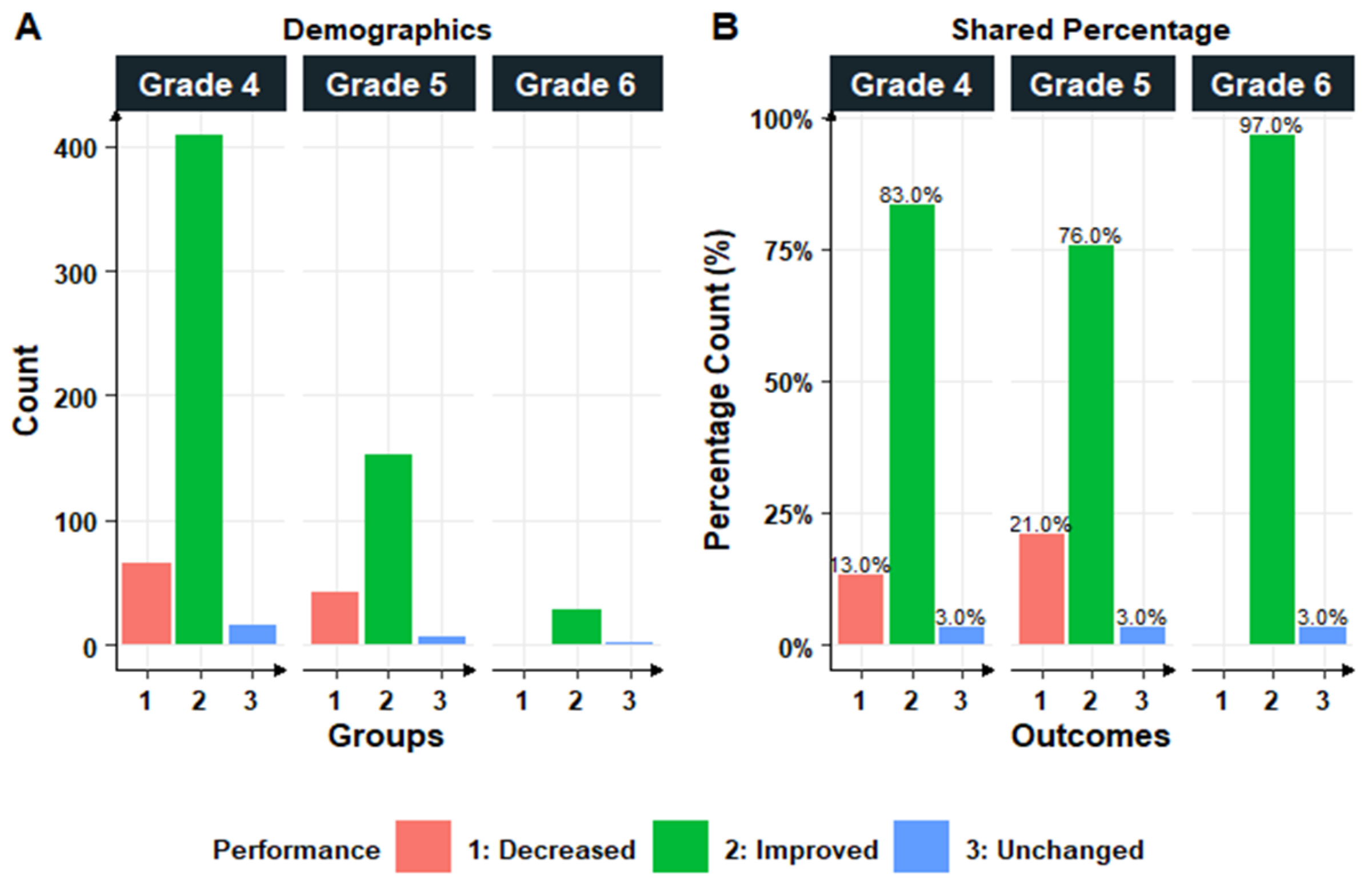
| Grade | Arithmetic Lessons | Other Featured Lessons | |
|---|---|---|---|
| Additions/Subtractions | Multiplications/Divisions | ||
| 4th | Addition and Subtraction; Addition and Subtraction with like fractions; Addition and Subtraction with unlike fractions; Addition and Subtraction with decimal numbers; Decimal numbers: Columnar addition and subtraction, comparing; Addition and subtraction with negative numbers. | Multiplication and division, order of operations; Multiplication tables; Division: partition; Columnar multiplication and long division; Remainders. | Expressions; Geometry: Lines, triangles and quadrilaterals; Coordinate plane; Fractions and mixed numbers; Decimal numbers; Hundredths; Units of length and mass; Time; Comparing and rounding integers; Negative numbers; Charts and graphs; Equations; Large numbers; Calculations with large numbers. |
| 5th | Basic Arithmetic Operations; Reducing fractions, adding and subtracting mixed numbers; Addition and subtraction with decimal numbers. | Multiplication, and Division; Multiplying and dividing fractions; Multiplying and dividing a decimal number. | Equations, problem solving and order of operations; Percentage, Fractions, integers and decimal numbers; Basics of geometry; Circles, and Triangles; Quadrilaterals and solid figures; Large, and mixed numbers; Tables, charts and diagrams; Mean, median and mode; Probability and Statistics; Measurement, Units of mass and volume; Time and speed; Area: Exponents and units; Area: Triangles and parallelograms; Similarity and scale; Reflection, Estimating, Coordinate system and sets. |
| 6th | Basic Arithmetic Operations; Addition and Subtraction with decimal numbers; Racer: Addition and subtraction. | Multiplication, and Division; Multiplication and division with decimal numbers; Multiplication and division with fractions. | Large, decimal numbers and fractions; Scales, geometry, measurement and maps; Triangles and Rectangular cuboids; Quadrilaterals and solid figures; Reducing fractions; Mixed numbers with common denominators; Expanding unlike fractions to common denominators; Calculating percentages; Prices, Time and units of time; Number line and equations; Negative numbers; Integers and the coordinate plane; Divisibility and factors; Functions; Calculating time intervals; Speed and time zones; Tables, graphs and charts; Probability; Racers; Problem solving. |
| Schools | Type | Number of Students | Total | ||
|---|---|---|---|---|---|
| Grade 4 | Grade 5 | Grade 6 | |||
| School 1 | Mixed | 236 | 172 | - | 408 |
| School 2 | Mixed | 161 | - | - | 161 |
| School 3 | Girls | - | 29 | 29 | 58 |
| School 4 | Mixed | 93 | - | - | 93 |
| Exercises * | Lessons | 4th Grade | 5th Grade | 6th Grade | ||||||
|---|---|---|---|---|---|---|---|---|---|---|
| f | % | Score | f | % | Score | f | % | Score | ||
| Mathematics Quiz | ARI | 654 | 10.09% | 157 | 4 | 0.46% | 44 | 3 | 0.31% | 26 |
| Mathematics Calculation Forms | NUM | 90 | 1.39% | 184 | 7 | 0.81% | 55 | 103 | 10.76% | 146 |
| Mathematics Calculation Rows | ADD/SUB | 526 | 8.11% | 202 | 128 | 14.87% | 155 | 124 | 12.96% | 371 |
| Mathematics Decimals | DEC | 3 | 0.05% | 44 | 33 | 3.83% | 130 | 22 | 2.30% | 141 |
| Calculation Fractions | FRA | 4 | 0.06% | 59 | 19 | 2.21% | 75 | 57 | 5.96% | 179 |
| Fill in Exercise | SUB | 137 | 2.11% | 47 | 0 | 0.00% | 0 | 0 | 0.00% | 0 |
| Audio Arithmetic | ARI | 536 | 8.27% | 179 | 257 | 29.85% | 258 | 68 | 7.11% | 261 |
| Match Pairs | MAO | 122 | 1.88% | 122 | 21 | 2.44% | 45 | 12 | 1.25% | 72 |
| Mathematics Driller | QUA | 2060 | 31.78% | 419 | 133 | 15.45% | 256 | 164 | 17.14% | 644 |
| Cards Game | - | 0 | 0.00% | 0 | 0 | 0.00% | 0 | 1 | 0.10% | 30 |
| Calculation Order | ARI | 777 | 11.99% | 616 | 57 | 6.62% | 122 | 213 | 22.26% | 559 |
| Number Exercise | ARI | 597 | 9.21% | 129 | 27 | 3.14% | 54 | 95 | 9.93% | 36 |
| Bubble Mathematics | - | 0 | 0.00% | 0 | 0 | 0.00% | 0 | 3 | 0.31% | 22 |
| Runner | ADD/SUB | 613 | 9.46% | 127 | 131 | 15.21% | 101 | 86 | 8.99% | 89 |
| Number Composition | NUM | 363 | 5.60% | 50 | 44 | 5.11% | 87 | 6 | 0.63% | 60 |
| Total | - | 6482 | 100.00% | 2331 | 861 | 100.00% | 1383 | 957 | 100.00% | 2637 |
| Cohorts | Pre-Assessment | Post-Assessment | t-Test | |||||
|---|---|---|---|---|---|---|---|---|
| School | Grade | N | s | s | t | p | ||
| School 1 | 4 | 236 | 46.14 | 16.97 | 53.72 | 16.06 | 9.20 | 0.00001 |
| School 2 | 4 | 161 | 44.64 | 17.53 | 56.65 | 19.57 | 10.9 | 0.00001 |
| School 4 | 4 | 93 | 46.41 | 17.65 | 58.60 | 19.73 | 11.19 | 0.00001 |
| School 1 | 5 | 172 | 53.49 | 20.64 | 62.13 | 17.97 | 7.58 | 0.00001 |
| School 3 | 5 | 29 | 50.34 | 13.80 | 58.34 | 17.23 | 4.97 | 0.00003 |
| School 3 | 6 | 29 | 57.83 | 22.35 | 73.86 | 28.54 | 6.80 | 0.00001 |
| Evaluation | N | s | t-Test | p | Sig. | Cohen’s d | |
|---|---|---|---|---|---|---|---|
| Pre-assessment | 720 | 48.24 | 18.60 | 19.69 | 2.2 × 10−16 | 0.01 | 0.51 |
| Post-assessment | 720 | 58.01 | 18.98 |
| Variables | Coefficient | Standard Error | t | p | CI (95%) |
|---|---|---|---|---|---|
| Constant | 26.343 | 4.656 | 5.658 | * | |
| X1 | 2.740 | * | |||
| X2 | 18.847 | * |
Publisher’s Note: MDPI stays neutral with regard to jurisdictional claims in published maps and institutional affiliations. |
© 2022 by the authors. Licensee MDPI, Basel, Switzerland. This article is an open access article distributed under the terms and conditions of the Creative Commons Attribution (CC BY) license (https://creativecommons.org/licenses/by/4.0/).
Share and Cite
Qushem, U.B.; Christopoulos, A.; Laakso, M.-J. Learning Management System Analytics on Arithmetic Fluency Performance: A Skill Development Case in K6 Education. Multimodal Technol. Interact. 2022, 6, 61. https://doi.org/10.3390/mti6080061
Qushem UB, Christopoulos A, Laakso M-J. Learning Management System Analytics on Arithmetic Fluency Performance: A Skill Development Case in K6 Education. Multimodal Technologies and Interaction. 2022; 6(8):61. https://doi.org/10.3390/mti6080061
Chicago/Turabian StyleQushem, Umar Bin, Athanasios Christopoulos, and Mikko-Jussi Laakso. 2022. "Learning Management System Analytics on Arithmetic Fluency Performance: A Skill Development Case in K6 Education" Multimodal Technologies and Interaction 6, no. 8: 61. https://doi.org/10.3390/mti6080061
APA StyleQushem, U. B., Christopoulos, A., & Laakso, M.-J. (2022). Learning Management System Analytics on Arithmetic Fluency Performance: A Skill Development Case in K6 Education. Multimodal Technologies and Interaction, 6(8), 61. https://doi.org/10.3390/mti6080061








